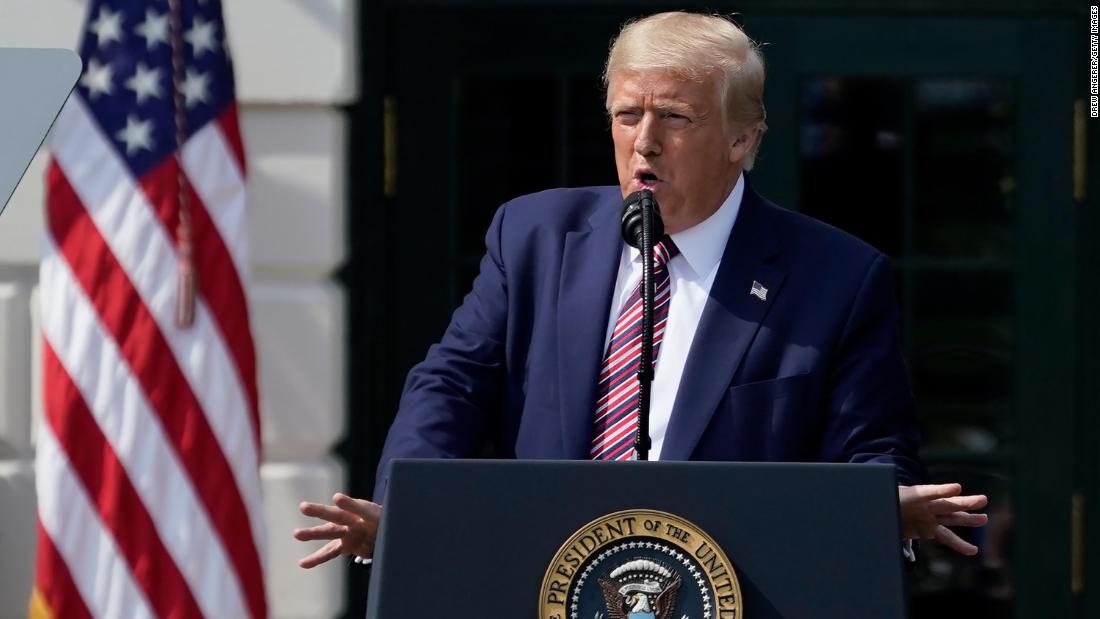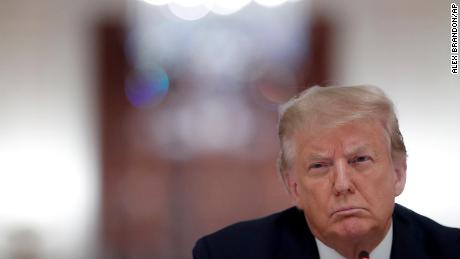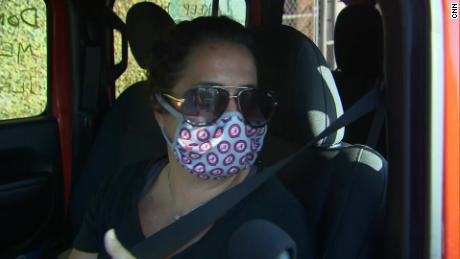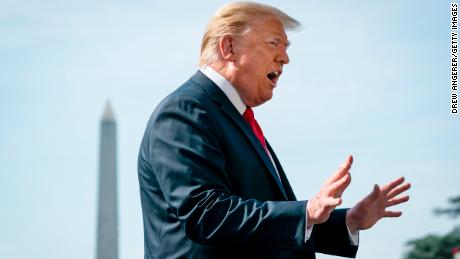Trump’s school reopening push a gamble aimed at White suburban voters
Yet as Trump pushes to fully open schools in a matter of weeks, his efforts are being met by defiant districts, worried parents and teachers, and confusion about what exactly his administration is recommending schools do to keep students safe should they open their doors.
Now, an effort that many inside the White House expected would prove widely popular has come to typify Trump’s halting efforts to confront the pandemic. He has undercut his administration’s public health experts in the name of returning the country to normal. Instead of providing clear instructions or mandates for how to combat the virus, Trump is issuing sweeping directives without saying how they should be achieved. And, through Trump’s own making, the issue has become a political litmus test alongside mask-wearing and public gatherings.
Additional guidance promised by the administration has been delayed. Internally, aides are scrambling to compile additional research to convince Americans that keeping kids at home poses more danger than sending them into classrooms after encountering unexpected resistance to their plans.
This week, White House officials and the US Centers for Disease Control and Prevention have sparred over the rollout of additional guidance meant to encourage school reopenings, creating another point of friction in a relationship that has remained tense throughout the pandemic response.
To some inside the White House, the urgency is months or weeks too late — coming well after administrators began determining plans for the fall and behind initiatives to open places viewed by some as less important drivers for the economy, such as gyms, restaurants and churches.
“We should have started with schools,” one senior administration official said this week. “Nothing can really reopen until the schools open.”
School push
For much of the spring — as coronavirus raged the first time and Trump began insisting states reopen their churches, restaurants and shops — a small group of his advisers urged him to focus on reopening schools instead.
But those arguments did not appear to register with the President. While he made a vocal push to reopen houses of worship and convened roundtables with restaurant owners and retailers, Trump did not turn his attention fully to schools until earlier this month.
By then, another surge in cases (prompted, in part, by the early reopenings) was spreading across the country. And districts — using guidance from the federal government that Trump later deemed overly burdensome — had already begun making decisions about their plans for the fall.
At the start of July, White House aides presented the school reopening push to Trump as a move likely to play well with working families — including the suburban moms Trump will need on his side to win a second term — and as a necessity for the country’s economic recovery to continue.
A report drafted by Trump’s Council of Economic Advisers and circulated among West Wing aides this month suggested students could suffer dire future consequences — including reduced earning potential and stalled career growth — if schools remain closed. The report also suggested that women, as primary caregivers, would suffer if students don’t return to in-person learning.
Trump’s visions for fully reopened schools have been threatened this week by a series of school closure announcements — including in the nation’s largest urban school districts — and polls showing concerns about in-person learning ran far deeper than previously known.
Still, the White House has remained adamant — and largely inflexible in the types of reopening they view as acceptable.
“When (Trump) says open, he means open in full, kids being able to attend each and every day at their school,” White House press secretary Kayleigh McEnany told reporters at the press briefing on Thursday. “The science should not stand in the way of this.”
She said the “science is on our side” with regard to bringing back students — a claim experts, teachers and parents have fiercely debated in recent weeks amid sparse data on the subject.
Trump himself has been among the loudest critics of the guidelines put forth by the CDC, which were released on June 30. Just days after CDC Director Robert Redfield announced the guidance — which calls for potentially challenging and expensive changes like spacing out desks, staggering drop-off times and installing physical barriers in close quarters — his team was planning for additional documents that they said would help address any confusion about what schools were being asked to do.
The development of those supplemental guidelines — expected to be roughly five pages long — hit snags internally, people familiar with the matter said, and the CDC delayed the release of them late Thursday evening after previously touting a release sometime this week.
“They’re not ready to come out this week,” a CDC spokesman told CNN on Thursday evening, adding there wasn’t a “clear picture at this point” on when the agency might release the documents.
Redfield recently briefed members of the White House coronavirus task force on the supplemental guidance, a person familiar with the conversion said, but the guidelines were not ready for wide distribution to the task force for a language review in time to meet the CDC’s self-imposed deadline.
Districts defy Trump
Despite the White House’s push to get students back in classrooms, some of the nation’s largest school districts have already announced plans to keep kids learning at home in the fall. Los Angeles Unified School District and San Diego Unified School District, California’s two largest districts, both announced on Monday there would be no in-person learning at the start of the school year. San Francisco, too, announced this week that all learning in the fall will be remote. And New York City schools have said they won’t reopen fully in September.
In Atlanta, schools will conduct classes virtually for the first nine weeks. In Houston, classes will be virtual for the first six weeks. And in major districts across the country, local officials are considering models that blend in-person and online learning — an option that Trump administration officials still oppose.
Trump’s team has argued, in addition to what they describe as the benefits for students, that school reopenings are necessary for the economic recovery to continue because working parents can’t return to the office if their children are not returning to the classroom.
Although the President repeatedly threatened to slash funding for schools that refuse his orders — something he has no authority to do — White House officials are working now on a plan to create financial incentives instead for districts that open.
Officials hope to include supplemental funding for schools in the next stimulus package and stipulate that schools can’t access the new money unless they take steps to reopen. The CDC is working with the White House budget office on incentivizing schools within the framework of reopening guidelines, an aide said, but it remains unclear whether congressional Democrats would get on board with a plan that could put closed schools at a disadvantage.
White House aides are also looking at whether they can redirect money included in the previous stimulus bill toward things necessary for school reopenings, such as PPE and sanitizing for districts.
The ‘obvious play’
Trump’s political advisers believe the push to reopen schools will prove popular among suburban woman, a group he is struggling with amid the pandemic and his unpopular views on race. His campaign has sought to contrast his push with rival Joe Biden, who has been more cautious in how schools should reopen.
A senior White House official called the school push the “obvious play,” beyond whatever politically advantageous groups might benefit.
Aides have sought to downplay polling that shows the majority of parents have concerns about sending their children back into classrooms with the virus still raging — with one comparing that level of concern to the worries parents tell pollsters they have about gun violence in schools, before sending their kids to class anyway.
Yet the White House is still seeking to bolster its case. Amid criticism of the CDC guidelines as too light in science, White House coronavirus response coordinator Dr. Deborah Birx has led a separate effort to put out more data backing up the drive to get students back to school, people familiar with the effort said.
Individual administration officials have argued at various points that there are academic, mental health and child safety considerations behind the argument for schools to reopen, but Birx and other White House officials have been working to collect those in one place to present to the public, the people familiar said.
Trump, meanwhile, has claimed in public that politics have tainted the school reopening debate.
“We have to open the schools. We have to get them open. And I think there’s a lot of politics going along,” he said at an event this week. “I think they think they’ll do better if they can keep the schools closed in the election. I don’t think it’s going to help them, frankly, but I think they feel that by keeping schools closed, that’s a bad thing for the country and, therefore, that’s a good thing for them.”
Some White House aides have downplayed announcements in individual districts that schools would remain shuttered, arguing they were never going to win the debate in Democratic strongholds.
And top administration officials, including Education Secretary Betsy DeVos, have spent the past week arguing that the benefits of in-person learning should outweigh the risks at schools across the country, regardless of a specific district’s coronavirus infection rate.
But pressed on specifics on how schools can accomplish reopening safely, DeVos has stumbled.
DeVos, a billionaire who was a top donor to Trump’s 2016 campaign, has long been a lightning-rod figure in the Trump administration, reviled by progressives who have accused her of trying to privatize education and a heroine of school voucher proponents, because of her many years bankrolling school choice efforts that opponents say would draw money away from public education.
While supportive of those efforts, Trump has also privately questioned DeVos’ ability to relay his message, believing she isn’t strong in interviews.
Still, the White House has relied on her over the past week to transmit the reopening message even as she remained largely absent during the earlier phases of the pandemic.
![]()








